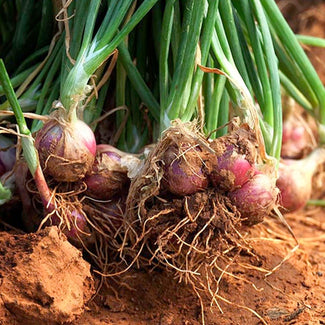
Season: Spring - Fall
Looking for a Specific Herb?
Search Our Herb Almanac Below:
|
|
|
Like garlic, shallots are formed in clusters of offsets with a head composed of multiple cloves. The skin color of shallots can vary from golden brown to gray to rose red, and their off-white flesh is usually tinged with green or magenta.
Shallots are extensively cultivated for culinary uses, propagated by offsets. In some regions ("long-season areas"), the offsets are usually planted in autumn (September or October in the Northern Hemisphere). In some other regions, the suggested planting time for the principal crop is early spring (typically in February or the beginning of March in the Northern Hemisphere).
In planting, the tops of the bulbs should be kept a little above ground, and the soil surrounding the bulbs is often drawn away when the roots have taken hold. They come to maturity in summer, although fresh shallots can now be found year-round in supermarkets. Shallots should not be planted on ground recently manured. Shallots suffer damage from leek moth larvae, which mine into the leaves or bulbs of the plant.
|
 |

Mature Height
36 Inches |
 |

Mature Width
24 Inches |
 |

Light
Sun |
 |

Water
Moderate |
 |
|
Uses
Shallots are used in cooking. They may be pickled. Finely-sliced deep-fried shallots are used as a condiment in Asian cuisine, often served with porridge . As a species of Allium, shallots taste somewhat like a common onion, but have a milder flavor.[14] Like onions, when sliced, raw shallots release substances that irritate the human eye, resulting in production of tears.
|
 |
|
RECIPES
Caramelized Shallots
Ingredients
• 3 tablespoons unsalted butter
• 1 lb. fresh whole shallots peeled (6 medium shallots)
• 1 tablespoon balsamic vinegar
• ½ teaspoon Diamond Crystal kosher salt
• ¼ teaspoon freshly ground black pepper
Instructions
1. Preheat your oven to 400 degrees F.
2. In a large oven-proof skillet, melt the butter over medium heat. Add the shallots, flat side down.
3. Cook, turning occasionally, until the shallots are browned, about 10 minutes.
4. Remove the pan from the heat and let it slightly cool. Drizzle the vinegar on top of the shallots, then sprinkle them with kosher salt and black pepper. Toss the shallots to coat them in the pan liquids.
5. Transfer the skillet to the oven. Roast the shallots for 10 minutes, flat side down. Carefully turn them to the other side and keep roasting until they are deeply browned and fork-tender (and smell amazing!), about 10 more minutes.
6. Divide the shallots between plates, spoon the pan sauce on top, and serve. You can garnish them with parsley if you wish.
|
|
















